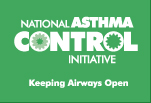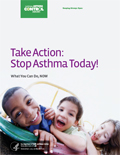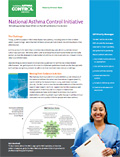States, Communities, and Coalitions
Solving the asthma problem in our communities means bringing people and resources together.
Reducing the public health burden of asthma through improved asthma control is a goal shared by state and local leaders, patients and their families, and other community stakeholders. Despite scientific advances in asthma management, avoidable hospitalizations, disability, and lost productivity due to asthma remain high. Asthma will cost the United States a projected $20.7 billion in 2010. Moreover, asthma has a disproportionate impact on children, low-income persons, and ethnic and racial minority populations. These groups experience above-average rates of asthma and asthma-related hospitalizations and emergency department visits.
Closing the disparities gap, and improving outcomes for all persons with asthma, requires a broad integration of clinical, educational, environmental, occupational, and public health approaches. By engaging diverse perspectives and strengths, states, communities, and coalitions can use available resources more efficiently to achieve better and more equitable outcomes.
Uniting for asthma-friendly communities.
Asthma-friendly communities champion improvements that put evidence-based asthma guidelines into practice by health care professionals, community organizations, and larger networks, environments, and care systems. Locally, it means increasing the capacity of clinics, medical offices, hospitals, emergency departments, pharmacies, homes, and schools and child care settings, to educate patients, families, and caregivers to monitor asthma control, use asthma medications, manage environmental triggers, and prevent or control asthma flare-ups
At state and community levels, controlling asthma also requires broader action. The Guidelines Implementation Panel (GIP) Report: Partners Putting Guidelines into Action encourages public agencies, legislative bodies, coalitions, and other concerned stakeholders to work together to develop and institute effective program and policy solutions that will improve:
- The quality of medical care
- Self-management support
- Care coordination and case management
- Outreach and community education
- Surveillance of disparities
- Control of environmental factors that affect asthma
- Housing quality
- Ambient air quality
- Community capacity to control asthma
Here are five steps that you can take to help make your state or community asthma-friendly:
- Collaborate with other stakeholders via coalitions, task forces, and other efforts.
- Conduct a needs assessment to identify and prioritize areas for improvement.
- Enhance surveillance of asthma prevalence, morbidity, mortality, and relevant risk factors.
- Build in accountability and measure results for continuous improvement.
- Advance policy to enhance care systems, public health structures, and environments.




















 Twitter
Twitter
 Facebook
Facebook YouTube
YouTube